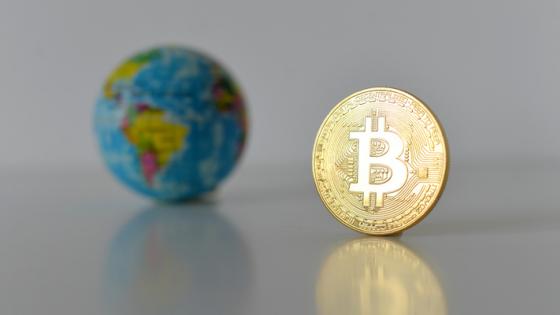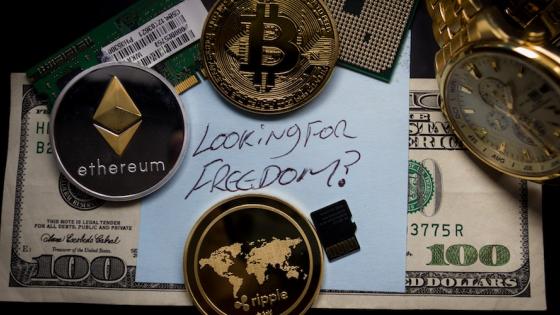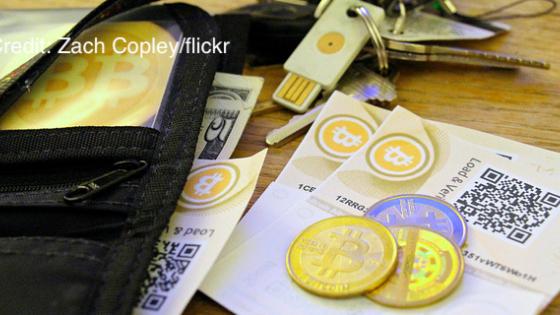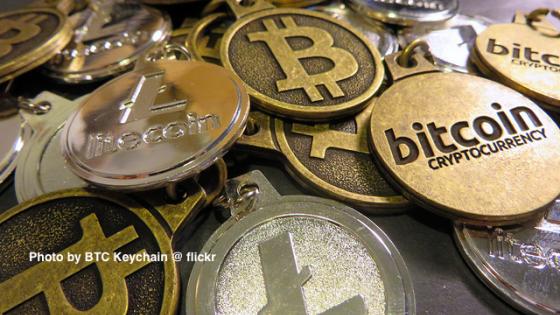The emergence of blockchain and related technologies for the production of cryptocurrencies like Bitcoin has the potential to fundamentally alter the ways the macroeconomic system, the money supply process, and the financial system operate. While it opens up a whole range of welfare enhancing opportunities, it also introduces new risks and problems. So far, attention has been focused on the large fluctuations in the price of a bitcoin, the lack of transparency about the producers of cryptocurrencies and their motives, the problems of security and potential hacking, the ease with which a digital currency like bitcoin can be used to finance illegal transactions, and the potential benefits of blockchain technology for the efficiency of the financial system.
This post is largely orthogonal to the above-mentioned issues. Its purpose is to highlight potential damages to the functioning of monetary policy instruments if government-produced fiat money is completely replaced by private money. To our knowledge, this issue has received little attention in the recent voluminous literature on cryptocurrencies. We illustrate the perils of a total shift from public to private money through the following counterfactual experiment. Suppose there were privately produced digital currencies with no problems of transparency and security, suppose that illicit use of such currencies was not possible, and that those currencies became accepted everywhere to carry out transactions. Within this context our main objective is to answer the following two questions:
- Is it desirable from a macroeconomic point of view to allow a situation in which most or all of world currency is issued privately rather than directly or indirectly by sovereign governments?
- Second, to the extent that the answer is negative, how can the efficiency gains of digital currencies in reducing transaction costs be realised in a system in which the ultimate authority for the total quantity of narrow money remains under the control of sovereigns or of public institutions designated by the sovereign?
The main drawback of totally privately produced digital currencies is that they strip the sovereigns and their designated public institutions (e.g. central banks) of important policy instruments. To sharply illustrate those drawbacks, we will focus on the following thought experiment. Suppose that appropriately devised regulation can totally eliminate the risks mentioned above making it possible to have a single privately producedworld currencywithout any involvement of governments and/or central banks.1 Would it be a good idea to support such a system? For brevity, we call the privately produced single world currency “Bitcoin”.
The major gain of such a system is obviously the reduction in world transaction costs. On the other hand, having Bitcoin as a world currency raises the following four macroeconomic problems:
1) The sovereign will lose an important monetary policy instrument and thus will be unable to conduct monetary policy to stabilise the economy in case of economic shocks, such as were witnessed during the recent financial crisis.
2) The sovereign will lose the seigniorage income from issuing its own currency and will have to replace this lost income by taxes which have welfare-reducing consequences.
3) The consequences of economic shocks to a single country will be harsher because there will be no adjustment in exchange rates that enable the mitigation of such shocks, as is the case today between countries or currency blocks.
4) Because Bitcoin is costly to produce, its use imposes a dead-weight cost on the world economy and annuls one of the great innovations of our time, the use of paper currency which is inexpensive to produce.
We provide details below. We expect that because of the harm that Bitcoin will create, it is in the best interest of sovereign governments to prohibit its use as a means of exchange and to contain its expansion.
The first part of this post will discuss and illustrate the above costs drawing on experiences from the recent and distant past. The second part will explore ways to realise the savings in transactions costs afforded by the new technology without giving up an important policy instrument of macroeconomic management.
The macroeconomic policy drawbacks of Bitcoin
Replacement of existing currencies by Bitcoin implies that central banks would no longer be able to conduct monetary policy for national stabilisation purposes as well as for the provision of swift responses to unforeseen exceptional budgetary and financial sector conditions. Consequently, the loss of control over monetary policy would be detrimental for a number of reasons under both normal and exceptional circumstances. This is briefly discussed and illustrated in the following discussion.
Normal circumstances
Under normal circumstances, the existing inflation target regimes used by practically all developed economies make it possible to maintain long-run price stability while stabilising fluctuations in national economic activity due to real and financial shocks. Although full-fledged inflation-targeting regimes came into being only during the 1990s, most central banks used monetary policy for stabilisation of the real economy prior to that while aiming at the maintenance of long-run price stability.
In open economies, an important channel through which monetary policy stabilises the domestic real economy is through changes in the real exchange rate. In a world characterised by sticky prices and wages, this is achieved through monetary policy-induced changes in the nominal exchange rate.2 In the presence of Bitcoin, this stabilisation instrument is nonexistent. Almost 60 years ago, Robert Mundell (1961) introduced the concept of an optimal currency area in which a single currency is optimal. The two important preconditions for a currency union to constitute an optimal currency area are capital mobility and labour mobility within the union. Since the world economies are currently characterised by relatively high levels of capital mobility, it may be argued that the first of those two requirements is close to being satisfied. It could even be enhanced by the emergence of a single world digital currency. However, labour mobility across different countries and regions is far from being perfect. Barriers due to different cultures, languages, religions, and mentalities are substantial and are quite likely to persist into the future. In addition, there are political barriers to the free migration of labour. The recent reluctance of European Union countries (including the UK), Australia, and the US to absorb migrants attest to that. Consequently, the world economy is far from constituting an optimal currency area.
The ability to bring about an adjustment in the real exchange rate by means of monetary policy is also useful when there are substantial cross-country differences in labour market institutions and/or in rates of change in productivity. In the presence of Bitcoin, countries whose labour unions are relatively less disciplined and/or have a lower rate of increase in productivity gradually become less competitive vis-à-vis the rest of the world. When the authorities of such countries possess the ability to affect the exchange rate by means of monetary policy, they can periodically offset the loss of competitiveness by means of nominal depreciation of the currency. Obviously, this would not be feasible in a world dominated by a single private world digital currency.
An example from the recent experience of the euro area illustrates this point. Once the members of the monetary union lost the ability to conduct independent monetary policy, countries like Spain, Greece, Portugal, and Italy persistently lost competitiveness in relation to Germany due to the relatively lower rates of increase in German unit labour. The adjustments that these countries had to undergo brought about depressed labour markets, unemployment, and cuts in public expenditures. The slow adjustment was caused, among other things, by the inability to quickly reduce real wages and to quickly increase labour productivity. For example, had Greece had its own currency, it would have devalued at an early stage, thus effectively cutting real wages in terms of the currency of the stronger euro area countries. If Bitcoin becomes a world currency, the painful adjustment process that some euro area countries had to undergo will become a worldwide phenomenon.
It should be emphasised that while changes in exchange rates can come about through active monetary policy, they can also occur when the monetary authority in a country is passive. For example, a natural disaster in a country that raises domestic prices induces a depreciation of its currency. By lowering the country’s prices on world markets, this ‘automatic stabiliser’ partially mitigates the negative effect on employment in the country. However, with a worldwide Bitcoin this cannot happen. Then, there will be a need for reduction in nominal wages and cuts in real expenditures to restore employment, a process that is normally slower.
It has been suggested that a single world digital currency is analogous to gold in that, due to the high marginal costs of producing it, it is likely to assure price stability as gold did in the UK during the 19th century. However, this analogy is not full and not entirely factually correct for the following reasons. First, under the gold standard the sovereign indirectly retained the monopoly on money creation by granting the right to issue currency at a fixed parity with respect to gold to a major private bank.[3]It also retained the right to temporarily abandon the gold standard and utilise the printing press to finance fiscal needs during periods of high expenditures like wars. Obviously, this would not be the case for a totally privately produced digital currency. Second, although the British price level was roughly the same at the beginning and the end of the 19th century, it fluctuated quite a bit in between due to gold discoveries and fluctuations in the real level of output (Bordo and Levin 2017).
Extreme circumstances
Under extreme circumstance, the ability to temporarily suspend the interdiction on expanding the money supply in times of economic crisis is likely to be useful, particularly in developing countries that have limited access to capital markets and that are subject to large shocks to real output.
Furthermore, control over a national currency makes it possible to partially reduce the real value of national debt that is denominated in domestic currency. This should not be construed as a recommendation for routinely engaging in such policy. However, the ability to do that under dire national circumstances is a sort of insurance that would not be available if all national currencies are replaced by a single privately issued digital currency.
As pointed out above, in case of a disaster in a country that leads to devaluation of its currency, the real value of national debt held by foreigners is reduced. This global risk sharing is an important welfare-enhancing consequence of having national currencies with flexible exchange rate. Global Bitcoin effectively means globally constant exchange rates, and this makes it impossible to have global risk sharing of national debts.
Furthermore, during major financial crises the ability of the central bank to act as a lender of last resort in order to avoid panics and preserve the integrity of the financial system cannot be exaggerated. The dismal experience of the Great Depression due to timid conduct of monetary policy and its reluctance to increase the money supply, and the relatively better performance of central banks during the recent financial crisis in providing a first line of defence against panics, attest to that. These crucial policy instruments will be lost in the presence of a Bitcoin because its supply is rigid.
Friedman and Schwartz (1963) have argued that much of the banking failures during the Great Depression could have been avoided if the Fed had acted as a lender of last resort. Being well aware of those insights, the governor of the Federal Reserve, Ben Bernanke, did not repeat this error. Under his leadership the Fed flooded financial markets with liquidity in order to compensate for the evaporation of private liquidity during 2007 and 2008. This partially appeased the simmering fears in financial markets until the much slower moving fiscal authority (Congress) came to the rescue (Bernanke 2015, Paulson 2010). Under a privately issued world digital currency the ability to quickly address similar problems in the financial system by means of monetary policy are nonexistent.
The more general point is that governments and central banks aim at the maximisation of national social welfare, while profit-motivated private issuers of a world currency do not internalise the impact of their actions for the rest of society. In a world dominated by political considerations, the attempts of public institutions to cater to the public interest may not be totally successful. However, being subject to public scrutiny and periodic elections, public officials are more likely to be closer to the maximisation of social welfare than private producer of a digital currency whose only objective is the maximisation of profits.
Seigniorage
The current consensus is that seigniorage should not be used to finance budgetary deficits. This consensus is embedded in practically all central banks' charters in advanced economies as well as in a good number of developing economies. This is done by means of a legal interdiction to directly lend to government for the purpose of financing budgetary deficits (Cukierman 2008). Seigniorage, however, is an important source of income for sovereign governments. Assuming that the demand for money is proportional to national income under normal circumstances and over the long run, governments can steadily increase the supply of money to accommodate the increased demand. For example, in the US the monetary base is a bit higher than 1/5 of national income, and thus a 5% increase in nominal income enables an increase in the base that is equivalent to 1% of national income without disrupting the economy. This is a considerable amount of resources (about $160 billion). Levying taxes to retrieve this amount – be it income taxes or corporate taxes or other forms of taxes – is associated with well-known dead-weight costs.
The dead-weight cost of production
Bitcoin is costly to produce. The energy used to ‘mine’ Bitcoin alone is higher than that used by some medium-sized countries. This costly mining is necessary because supply of any credible means of exchange must be limited. If it were costless to produce and its supply were unlimited, it would have had no value. In this sense, Bitcoin is like gold or any precious resource that becomes a means of exchange. Just as the production of gold entails real resources, so is the production of Bitcoin. Although the early issue of bank notes or paper money provided simply a promise to the bearer to redeem it for a stated commodity such as gold, it later became a legal tender for transactions regardless of it being backed by any commodity. As such, humanity saved on the real resources that would be required in order to mine trillions of dollars of rare metals (or produce other rare commodities) to back the paper money. The use of resource-saving paper money is considered a great innovation.4
However, Bitcoin reverses this gain in human history. As pointed out, its production consumes real resources that could have been employed elsewhere. Its function as a means of exchange can be provided by paper money whose supply is controlled by the sovereign, which is almost costless to produce.
How can existing monetary institutions internalise the benefits of digital currencies without giving up monetary policy?
Central banks can appropriate some of the benefits of the new technology of digital currency without abandoning the monetary policy instrument by issuing their own publicly provided digital currencies that would be freely convertible, at a fixed one-to-one exchange rate, into cash and paper currencies. Unlike privately produced digital currencies, a central bank digital currency (CBDC) would have the status of legal tender so that the traditional definition of narrow money (M1) would now include, in addition to demand deposits and cash held by the public, also the CBDC. As is the case with cash and demand deposits, the distribution of the three components of the wider M1 concept would be determined by the public’s relative demand for them.5
To date the views of major central banks on the desirability of issuing a CBDC are mixed. On one hand, they are attracted by the efficiency gains that can be obtained through the incorporation of the new technology. On the other hand, some are worried that it may interfere with the functioning of the private banking system, particularly if the public is allowed to hold deposits at the central bank. There are two types of concerns. One is that such a move will drastically reduce demand deposits in the banking system, stripping private banks from an important source of funds. The other (expressed, among others, by Bank of England Governor Mark Carney) is that during crisis times all funds will swiftly flow into the central bank, forcing it to reluctantly assume the role of a major financial intermediary.
But abstaining from providing a public alternative to privately produced digital currencies carries the risk that sooner or later those currencies will largely replace legal tender. Recognising this risk, most central banks are currently researching the various options for eventually adopting some form of CBDC. Some, like the Dutch central bank, have even experimented on a limited basis with such a currency and the Federal Reserve is considering the issue of Fed coin.
Endnotes
[1]The assumption of a single private currency is made for simplicity and does not invalidate the broad arguments in the rest of the column.
[2]The notion of sticky prices and wages goes back to Keynes (1936) and its modern incarnation is represented by the New-Keynesian literature. Woodford (2003) and Gali (2008), among others, are standard references to this extensive literature.
[3]The private banks that got this charter eventually became central banks. Well known examples are the Bank of England and the Riksbank (Cukierman 2018).
[4]Paper money was (arguably) first introduced in China during the Song Dynasty (960 – 1279), under official government license. However, it was still backed by metal coins.
[5] Bordo and Levin (2017) investigate various options for the implementation of such a system.



